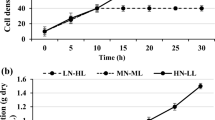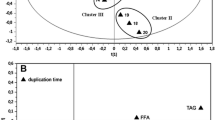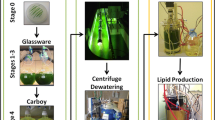Abstract
The marine coccolithophore, Emiliania huxleyi, grown in the laboratory was subjected to vacuum pyrolysis at various temperatures from 100 to 500 °C. The highest yield of pyrolytic gases (183 mL g−1 dry cells) was obtained at 400 °C. The amount of total hydrocarbon gas produced at 400 °C was 129 mL, about 10 times higher than at 300 °C. CH4 was the major component at the high gas-production stage (400–500 °C). The great increase in hydrocarbon gases at 400 °C was accompanied by a marked decrease in liquid saturates and aromatics. The results indicate that the liquid hydrocarbons (oil) produced by pyrolysis at lower temperature is a direct source for the formation of the hydrocarbon gases. Due to its large potential for the production of biomass and hydrocarbons with low energy input, E. huxleyi is suggested as one of candidates for the production of renewable fuels.
Similar content being viewed by others
References
Conte MH, Thompson A, Eglinton G (1995) Lipid biomarker diversity in the coccolithophorid Emiliania huxleyi (Prymnesiophyceae) and the related species Gephyrocapsa oceanica. J. Phycol. 31: 272–282.
Fernandez E, Boyd P, Holligan PM, Harbour DS (1993) Production of organic and inorganic carbon within a large-scale coccolithophore bloom in the northeast Atlantic Ocean. Mar. Ecol. Progr. Ser. 97: 271–285.
Ferrero G, Maniatis K, Buekens A, Bridgewater A (1989) Pyrolysis and Gasification. Elsevier, Amsterdam, pp. 326–333.
Ghetti P, Ricca L, Angelini L (1996) Thermal analysis of biomass and corresponding pyrolysis products. Fuel 75: 565–573.
Ginzburg B (1993) Liquid fuel (oil) from halophilic algae: a renewable source of non-polluting energy. Renewable Energy 3: 249–252.
Grange P, Laurent E, Maggi R, Centeno A, Delmon B (1996) Hydrotreatment of pyrolysis oil from biomass: reactivity of the various categories of oxygenated compounds and preliminary techno-economical study. Catalysis today 29: 297–301.
Okada H, McIntyre A (1977) Modern coccolithophores of the Pacific and North Atlantic Oceans. Micropaleontology 23: 1–55.
Okaichi T, Nishino S, Imatomi Y (1982) Collection and Mass Culture of Toxic Phytoplankton–Occurrence, Mode of Action, and Toxins. Society of Science of Fisheries, Kouseisha-Kouseikaku, Tokyo, pp. 23–34.
Pakel H, Roy C (1991) Hydrocarbon content of liquid products and Tar from pyrolysis and gasification of wood. Energy & Fuel 5: 427–436.
Raveendran K, Ganesh A (1996) Heating value of biomass and biomass pyrolysis products. Fuel 75: 1715–1720.
Richard JR (1996) Algal diversity and commercial algal products. BioScience 46: 263–270.
Westbroek P, Brown CW, van Bleijswijk J, Brownlee C, Brummer GJ, Conte M, Egge J, Fernandes E, Jordan R, Knappertsbusch M, Stefels J, Veldhuis M, van der Wal P, Young J (1993) A model system approach to biological climate forcing, the example of Emiliania huxleyi. Global Planet Change 8: 27–46.
Williams PT, Besler S (1996) The influence of temperature and heating rate on the slow pyrolysis of biomass. Renewable Energy 7: 233–250.
Williams PT, Horne PA (1995) Analysis of aromatic hydrocarbons in pyrolytic oil derived from biomass. J. anal. appl. Pyrolysis 31: 15–37.
Wu Q, Sheng G, Fu J (1989) Components of natural gas resulting from thermal degradation of the blue-green alga (cyanobacterium) Oscillatoria tenuis. J. appl. Phycol. 1: 285–287.
Wu Q, Yin S, Sheng G, Fu J (1992) A comparative study of gases generated from simulant thermal degradation of autotrophic and heterotrophic Chlorella. Progress in Natural Science 2: 311–318.
Wu Q, Zhang B, Grant NG (1996) High yield of hydrocarbon gases resulting from pyrolysis of yellow heterotrophic and bacterially degraded Chlorella protothecoides. J. appl. Phycol. 8: 181–184.
Author information
Authors and Affiliations
Rights and permissions
About this article
Cite this article
Wu, Q., Dai, J., Shiraiwa, Y. et al. A renewable energy source — hydrocarbon gases resulting from pyrolysis of the marine nanoplanktonic alga Emiliania huxleyi. Journal of Applied Phycology 11, 137–142 (1999). https://doi.org/10.1023/A:1008075802738
Issue Date:
DOI: https://doi.org/10.1023/A:1008075802738




